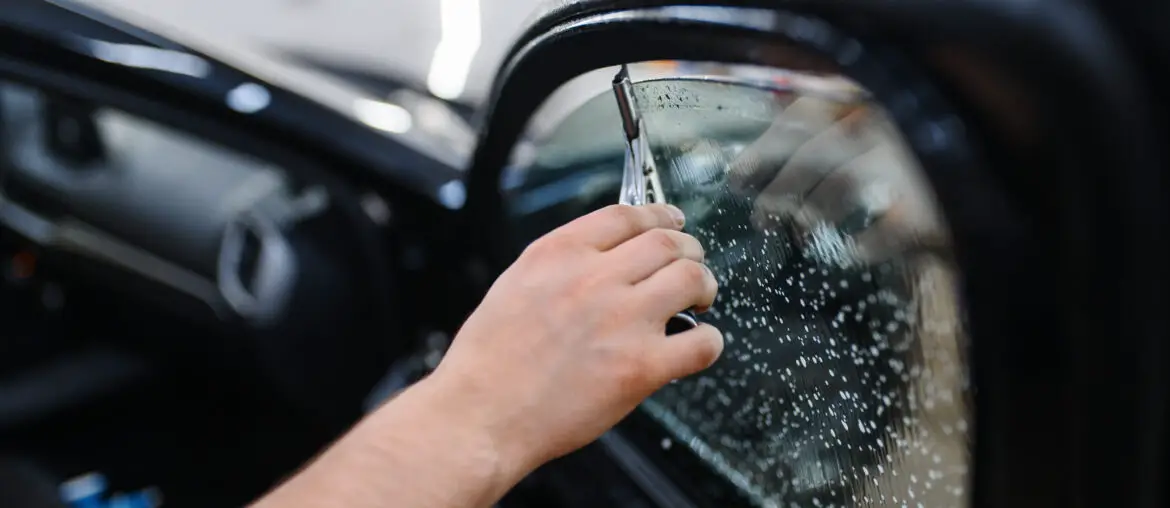Ohio window tinting laws should be studied well before you go ahead with your work of window tinting. Especially because the laws differ from one state to another, you would have to check with your state’s updated laws. Even when you are going to buy a vehicle, you should be concerned about this, as selling vehicles that do not meet the criteria are also illegal.
Table of Contents
Ohio Window Tinting Law

Ohio window tinting laws were enacted in 2004. This state was the 43rd state to enact tinting laws out of the 50 states. There are various percentages of light allowed to pass through the car window tint. It is measured as the Visible Light Transmission factor (VLT). The higher this value, the higher the light passed into the vehicle interior. The specifications on this are indicated below.
Window Tint Darkness in Ohio
In terms of the Visible Light Transmission factor, the amount of darkness allowed in various states would be different. The darkness allowed in the state of Ohio is as follows.
Tint darkness for sedans, SUVs, and vans:
- Windshield: Non-reflective tint is allowed on the top 5 inches of the windshield.
- Front Side windows: Must allow more than 50% of light in.
- Back Side windows: Any darkness can be used.
- Rear Window: Any darkness can be used.
The above rules are applicable for multi-purpose vehicles in the state as well.
Window Tint Reflection in Ohio
Some states allow highly reflective window tints that are almost mirror-like to be used in their state and have no restrictions. But, there are restrictions to this in the state of Ohio. They are indicated as follows.
Tint reflection for sedans, SUVs, and vans:
- Front Side windows: No reflectorized materials permitted.
- Back Side windows: No reflectorized materials permitted
If you need to refer to what darkness is created by the relevant VLT percentages of the vehicle window tints, then you can look up in the Window Shades Chart.
Other Ohio Window Tint Rules and Regulations:
- Side Mirrors
There are no restrictions for side mirrors in Ohio. If the view from the windshield mirror is obstructed, then side mirrors would be required.
- Restricted Colors
Usually, most of the states have banned certain tint colors on vehicle windows. However, no colors of tint are banned here. All tint colors are allowed.
- Certificates and Stickers
The tint films should be certified by the manufacturer before they sell them in Ohio. It is recommended to clarify this with your dealer by asking if they are using certified film. Moreover, there should be a sticker between the film & glass on each tinted window to identify legal tinting. This should be given by the window tint installing company.
- Medical Exceptions and Waivers
Most of the states allow medical exemptions for people with medical conditions such as photophobic and need to avoid direct sunlight. But, there are no medical exemptions allowed in the Ohio tint laws for special tint. However, if there is anyone who would need a medical exemption, then an appeal can be made to the state on this by contacting the Ohio State Representative. You would also need a recommended prescription from a licensed physicist or a dermatologist for this.
- Penalties
If a driver is caught for violating the window tint laws, then that person would be charged with a misdemeanor moving violation. The cost of the fine would be around $120 in total.
It is always better to get a proper window tint installed than to pay the fines. So, if you need to find the budget you need for installing new window tints, refer to How Much to Tint Car Windows.
FAQs on Ohio Tint Laws
Let’s see some of the frequently asked questions about window tint laws in the state of Ohio.
What is the Darkest Legal Tint in Ohio?
The darkest legal tint in Ohio is considered as 50% VLT. Therefore, this is not as strict as some other states where a very high VLT level is required and low darkness is allowed on the window tints. Also, there are other states such as Florida that allow even lower VLT percentages like 28% on the front windows and allow up to 15% on the back and rear windows.
Is it Possible to Get a Window Tint Penalty for a Vehicle from Another State?
Usually, most of the states have the discretion to determine if they want to hold back any vehicle traveling from another state with violation of regulations in this state. However, most states act in fairness and consider the laws where the vehicle is originally from and allow them to pass through. Nevertheless, it is good to know about this and that there is a chance of getting pulled over in whatever the state is if you do not abide by the legal limitations.
So before you travel across any state, make sure to know everything about them and what their state recommendations are, related to the legal restrictions on car window tinting. For this, you may refer to Car Window Tint Laws in the U.S. by State.
The Differing Law Enforcement
The level of enforcement of the law could be unpredictable. This would be determined by the individual police departments of the state. Sometimes they would not even issue a citation for the window tint, while some would strictly adhere to the conditions and enforce the laws strictly. If you were issued with a “fix-it ticket”, then you would have to get the window tint removed and get your vehicle inspected by the court. So, to avoid any inconvenience, it is highly recommended to abide by the state’s laws at all times.
If you need to remove your car window tint, then you would need to refer to How to Remove Car Window Tint.
If you do not want to install window tints, you can have another option of Privacy Glass windows which are installed by the vehicle manufacturers. However, make sure to refer to your state laws and clarify the VLT percentages before you choose this.
State of Ohio Information
The state of Ohio is situated in the Midwest of the United States. It is the 34th largest by area and also the 7th most populous state. Out of all the 50 states, Ohio is the most densely populated state. Its capital is Columbus and also the largest city. The population is over 12 million and the total area is 44,825 square miles (116,096 square kilometers). The revised code section related to Ohio window tinting laws is 4513.241 which is about using tinted glass and other vision-obscuring materials.
*Keep in mind that Ohio tint laws can change daily and may be interpreted differently in your city or county. To be sure, we recommend double-checking our information with your local DMV or Law Enforcement Authorities. Furthermore please let us know if there are any changes to make.








